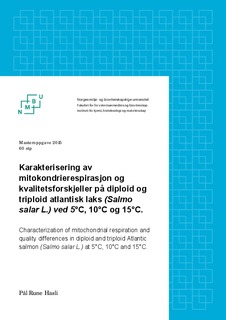Karakterisering av mitokondrierespirasjon og kvalitetsforskjeller på diploid og triploid atlantisk laks (Salmo salar L.) ved 5°C, 10°C og 15°C.
Master thesis
Permanent lenke
http://hdl.handle.net/11250/284932Utgivelsesdato
2015-06-11Metadata
Vis full innførselSamlinger
- Master's theses (KBM) [890]
Sammendrag
Min motivasjon og bakteppet for arbeidet med denne masteroppgaven er norsk
laksenærings kanskje mest omtalte lisensutdeling gjennom tiden: «De grønne A
konsesjonene» i Troms og Finnmark, effektuert av Erna Solberg (H) sin 1. regjering ved
fiskeriminister Elisabeth Aspaker (H). Her baseres 60 % av lisensene (12 av 20) på bruk
av triploid laks. Denne laksetypen omtales også som steril laks.
Atlantisk laks ±1kg med diploid og triploid status, og tre forskjellige temperaturregimer
(5°C, 10°C og 15°C) ble i to måneder holdt i seks forskjellige kar inne på
Havforskningsinstituttets forskningsstasjon, «Miljøhallen» på Matre i Masfjorden
kommune, (60°52′31″N 5°35′2″Ø). I august 2014 ble fisken slaktet og analysert.
Oppgaven har tatt for seg sammenligning av diploid og triploid laks med flere
kvalitetsparametere. I tillegg til dette har det blitt utført karakterisering av
mitokondrierespirasjon på diploid og triploid laks både før og etter smoltifisering i rød
muskel, samt hjertet. For å kunne analysere mitokondrier, ble vevshomogenisering med
shredder PSI-HRR for opparbeiding av prøve benyttet og testet mot bruken av biops
m/saponin som oppløser cellemembraner, noe som gjør mitokondriene tilgjengelige for
analyse.
Det er ploide forskjeller i rigor-mortis forløpet, da triploid laks har signifikant mykere
(<0,001) rigor sammenlignet med diploid laks ved de tre temperaturene der analyse ble
foretatt.
Kvalitetsanalysene viser at diploid og triploid laks har få til ingen markante
kvalitetsforskjeller. Analysene viser nominelt høyere drypptap hos triploid laks.
Fiskefiletene med størst muskelsammentrekning var filetene med mest drypptap
uavhengig av ploiditet. Collagenaseaktviteten er signifikant høyere (<0,05) i triploid
laks enn i diploid laks. Triploid laks har høyere fettdeponering enn diploid laks.
Mengden av karotenoidet astaxanthin er lik i de analyserte fiskene. HunterLab
verifiserer likt fargebilde hos diploid og triploid laks.
Mitokondrierespirasjonen hos laks er ikke direkte påvirket av ploiditet. Mitokondriene
er godt koblet. Mitokondriene lot seg ikke avkoble med FCCP, og av den grunn
fungerer ikke FCCP som en avkobler hos mitokondrier i laks. Respiratorisk restoksygen i hjertet hos triploid laks i sjøvannfasen var signifikant høyere
(<0,05) fra diploid laks. Årsaken til dette kan muligens være forskjellen i
fettsyresammensetning hos diploid og triploid laks. Det var signifikant høyere (<0,05)
ADP-respons i ferskvannsfasen hos triploid laks enn hos diploid laks, dette kan ha
betydning for veksthastigheten i ferskvann.
Shredder ga høyere oksygenrespons ved samme vevsmengde (<0,001) enn biops
m/saponin i oxyografen.
Måling av protein i oxyografen må gjøres ved å ta ut alt vevet, og deretter løse det opp.
Da en mest sannsynlig bare tok ut deler av oppløsningen i kammerne, er de
mitokondrielle dataene basert på innveid våtvekt og succinate respons. My motivation and reason for this work with my master thesis is due to Norwegians
salmon industry perhaps the most cited license distribution through all time: “The green
A licensing” in Troms and Finnmark, effectuated of Erna Solberg (H) first government
by the Minister of fisheries Elisabeth Aspaker (H). 60 % of all licenses (12 of 20) are
based on use of triploid salmon. This type of salmon is also referred to sterile salmon.
Atlantic salmon ±2.2 pounds with diploid and triploid status, and three different
temperature regime (5°C, 10°C and 15°C) were in six different wats for two months. It
was localized at hall of Environment, Institute for Marine Research, Matre in the rural
district Masfjorden (60°52′31″N 5°35′2″Ø). In August 2014, the fish were slaughtered
and analysed.
The thesis has focused on the comparison of diploid and triploid salmon with several
quality parameters. In addition to this, there has been performed characterization of
mitochondrial respiration at diploid and triploid salmon before and after smoltification
on red muscle, as well as the heart. To analyse the mitochondria tissue homogenization
with Shredder PSI-HRR for preparation of sample was used and tested against Biops
with/Saponin, which dissolves cell membranes making mitochondria available for
analysis.
There are ploidy differences in rigor-mortis precursor. Triploid salmon has significantly
softer (<0.001) rigor compare with diploid salmon at the three analyzed temperatures.
The quality analyses showed that diploid and triploid salmon have no clear quality
differences. The analyses show nominal higher drip loss of triploid salmon. The fish
filet with the highest level of muscle contraction was the filet with highest amount of
drip loss independent of ploidy. Collagenase activity is significantly higher (<0.05) in
triploid salmon compared with diploid salmon. Triploid salmon has a higher fat
deponation than diploid salmon. The amount of the carotenoid astaxanthin is equal in
the analysed fish. HunterLab verify equal colour image at diploid and triploid salmon.
Mitochondrial respiration of salmon is not directly affected by plowedity. The
mitochondria is well coupled in salmon. The mitochondria was not uncouple with
FCCP, and of this reason FCCP does not work as an uncoupler of mitochondria in
salmon. Respiratorical leftover oxygen in the heart at triploid salmon in seawater was
significantly higher (<0.05) than that of diploid salmon. The reason for this can possibly
be the difference in the fat acid composition at diploid and triploid salmon. It was a
significantly higher (<0.05) ADP-response in freshwater phase of triploid salmon
compared to diploid salmon. This may affect growth rate in freshwater.
Shredder gave higher oxygen response in the same tissue volume (<0.001) than biops
with/saponin in the oxyograph.
The measuring of proteins in the oxyograph is to be done by taking out all the tissue
from the chamber, and after that dissolve it. Most probably, it was taken out just a small
part of the solution in the chamber. The mitochondrial results are based on weighed wet
weight and succinate response.
